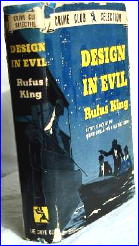Sun 6 Sep 2009
RUFUS KING – Design in Evil. Doubleday Crime Club, hardcover, 1942. Reprint paperbacks: Thriller Novel Classic #21, 1943; Popular Library #124, paperback, 1948.
Design in Evil is the first of King’s non-series thrillers, after he abandoned the formal detective novel with Holiday Homicide (1940).

The early chapters (1-13) are well written, with King showing in detail the trap that confronts his heroine. These chapters show King’s feel for sailing material, taking place on a sea going yacht.
Unfortunately, the book as a whole is flat. Design in Evil is in the tradition of the “innocent young woman forced into a new identity” school. It follows such pioneering works as Helen McCloy’s The Dance of Death (1938), and Anthony Gilbert’s The Woman in Red (1941), the latter being made into a superb film directed by Joseph H. Lewis, My Name is Julia Ross (1945).
The story is never plausible, unless everyone is in on this bizarre plot; yet King wants only one person to be guilty, and everyone else to be an innocent dupe. The later sections of the book contain a murder mystery. However, there are only two serious suspects, and the mystery is never developed into an interesting or even very elaborate plot.
King indicates that Joseph Conrad is one of his hero’s favorite authors (Chapter 15). It certainly makes sense that King admires Conrad: both were sailors in real life, and wrote frequently about the sea, and both men wrote rich descriptive prose.
King is of two minds about psychiatry, then becoming unfortunately fashionable in the media. Psychiatry is treated as a serious science, and yet the older psychiatrist is the book is shown as a completely mistaken dupe. This is at least more skeptical than the religious reverence with which psychiatry was usually held in this era.
Editorial Comment: You should go back, of course, and compare and contrast Mike’s review of this book with that of Bill Deeck’s, which I posted here earlier this morning.
If you follow the link in the paragraph above, you’ll find a long section of Mike’s website devoted to reviews and analysis of Rufus King’s work. At the risk of overdoing a good thing, I’m planning on posting one or two more of those reviews on this blog. Look for them tomorrow, if all goes well.
September 7th, 2009 at 3:22 am
Ironically another King, C. Daly, took an even more jaundiced view of psychiatry in his Obelist books. Obelist at Sea takes some some well aimed shots at various schools of the science as a group of psychiatrists on an ocean cruise try to solve a murder by applying their “theories” and undercover New York policeman Captain Michael Lord uses them to help track down the real killer.
Francis Beeding’s House of Dr. Edwardes isn’t all that kind to the practice either, though the Hitchcock film Spellbound based loosely on it is a bit more reverent.
You are 100% right on My Name is Julia Ross, and remade well by Arthur Penn as Dead of Winter.